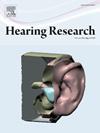探讨尸体头部固定在骨传导听力中的作用:来自有限元模型的见解
IF 2.5
2区 医学
Q1 AUDIOLOGY & SPEECH-LANGUAGE PATHOLOGY
引用次数: 0
摘要
本研究采用全头部有限元模型对实验数据进行验证,探讨了头部固定方法对骨传导(BC)反应的影响。通过改变材料杨氏模量、调整固定位置、修改固定点垂直位置,系统分析固定强度、位置、高度、颈部支撑等边界约束变量。其中,固定强度对同侧和对侧耳蜗海突速度的影响最为显著。牢固的固定使界面变形最小化,使颅骨的内在力学特性能够塑造海岬速度,而松散的固定产生均匀的响应,无论颅骨的特性如何。固定位置和高度对同侧和对侧海岬速度的影响很小,颈部支撑强度的影响可以忽略不计,因为软组织顺应性占主导地位。此外,由于颅骨的杨氏模量可以在尸体标本中变化,因此还通过改变皮质骨的杨氏模量来研究其对不同边界约束下骨传导响应的影响。在坚固固定条件下,皮质骨的杨氏模量对同侧和对侧海岬速度均有显著影响,但在松动固定条件下影响有限。经颅衰减在很大程度上不受边界约束的影响,反映了颅骨的内在变形行为。这些发现强调了头固定方法强度在BC实验中的关键作用。在松固定下,海岬速度几乎不受固定位置、高度或皮质骨杨氏模量的影响。相比之下,牢固固定放大了皮质骨杨氏模量对海岬速度和经颅衰减的影响,使其更适合于分离颅骨固有行为。这些发现表明,固定策略的选择必须与BC研究的目标相一致。本文章由计算机程序翻译,如有差异,请以英文原文为准。
Exploring the effect of cadaver head fixation in bone conduction hearing: Insights from finite element modeling
This study investigates the effects of head fixation method on bone conduction (BC) responses using a full head finite element model validated against experimental data. Boundary constraint variables, including fixation strength, location, height, and neck support, were systematically analyzed by varying material Young’s modulus, adjusting fixation positions, and modifying the vertical position of fixation points. Among them, fixation strength had the most significant impact on ipsilateral and contralateral cochlear promontory velocities. Firm fixation minimized interface deformation, enabling the skull’s intrinsic mechanical properties to shape promontory velocities, while loose fixation produced uniform responses regardless of skull properties. Fixation location and height showed minimal effects on ipsilateral and contralateral promontory velocities, and neck support strength exhibited negligible influence due to the dominance of soft tissue compliance. Furthermore, since the Young’s modulus of the skull can vary across cadaver specimens, its influence on bone conduction responses under different boundary constraints was also examined by changing of Young’s modulus of the cortical bone. Young’s moduli of the cortical bone significantly influenced both ipsilateral and contralateral promontory velocities under firm fixation conditions but had limited effects under loose fixation conditions. Transcranial attenuation was largely unaffected by boundary constraints, reflecting the skull's intrinsic deformation behavior. These findings highlight the critical role of head fixation method strength in BC experiments. Under loose fixation, promontory velocities were little affected by fixation location, height, or Young’s modulus of the cortical bone. By contrast, firm fixation amplifies the effect of Young’s modulus of cortical bone on promontory velocity and transcranial attenuation, making it more suitable for isolating intrinsic skull behavior. These findings demonstrate that fixation strategy must be chosen to align with the objectives of BC research.
求助全文
通过发布文献求助,成功后即可免费获取论文全文。
去求助
来源期刊

Hearing Research
医学-耳鼻喉科学
CiteScore
5.30
自引率
14.30%
发文量
163
审稿时长
75 days
期刊介绍:
The aim of the journal is to provide a forum for papers concerned with basic peripheral and central auditory mechanisms. Emphasis is on experimental and clinical studies, but theoretical and methodological papers will also be considered. The journal publishes original research papers, review and mini- review articles, rapid communications, method/protocol and perspective articles.
Papers submitted should deal with auditory anatomy, physiology, psychophysics, imaging, modeling and behavioural studies in animals and humans, as well as hearing aids and cochlear implants. Papers dealing with the vestibular system are also considered for publication. Papers on comparative aspects of hearing and on effects of drugs and environmental contaminants on hearing function will also be considered. Clinical papers will be accepted when they contribute to the understanding of normal and pathological hearing functions.
 求助内容:
求助内容: 应助结果提醒方式:
应助结果提醒方式:


